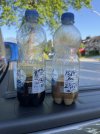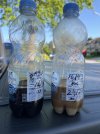He didn't say condensation, he said vapor.Lot more oil/fuel than condensation
5thGenRams Forums
You are using an out of date browser. It may not display this or other websites correctly.
You should upgrade or use an alternative browser.
You should upgrade or use an alternative browser.
Oil catch can
- Thread starter Nascar Tommy
- Start date
lapoolboy
Well-Known Member
- Joined
- Mar 5, 2022
- Messages
- 234
- Reaction score
- 319
- Points
- 63
- Age
- 47
Vapor condensates into liquid.He didn't say condensation, he said vapor.
You do realize the purpose of the catch can is to catch the vapors and collect it as condensated liquid.He didn't say condensation, he said vapor.
No, actually I thought the purpose was to catch the oil and particulates carried by the PVC vapors. Your own photo seems consistent with that. If you want to condense all the water vapor too, I think you'll need a lot bigger container and keep it significantly cooler than the engine. Near as I can tell, water vapor is no problem for the engine to recycle. Heck, ambient air is loaded with the stuff. Oil you can make an argument for, and particulates definitely good to catch. That's my take on it.You do realize the purpose of the catch can is to catch the vapors and collect it as condensated liquid.
In winter, you will see a lot more water condensation. Sometimes it will drain out looking like a milkshake. Catch can placement has some to do with it as well. If your engine is operating at the correct operating temperature, there shouldn't be much water vapor in the crankcase to condensate.No, actually I thought the purpose was to catch the oil and particulates carried by the PVC vapors. Your own photo seems consistent with that. If you want to condense all the water vapor too, I think you'll need a lot bigger container and keep it significantly cooler than the engine. Near as I can tell, water vapor is no problem for the engine to recycle. Heck, ambient air is loaded with the stuff. Oil you can make an argument for, and particulates definitely good to catch. That's my take on it.
ferraiolo1
Spends too much time on here
No, actually I thought the purpose was to catch the oil and particulates carried by the PVC vapors. Your own photo seems consistent with that. If you want to condense all the water vapor too, I think you'll need a lot bigger container and keep it significantly cooler than the engine. Near as I can tell, water vapor is no problem for the engine to recycle. Heck, ambient air is loaded with the stuff. Oil you can make an argument for, and particulates definitely good to catch. That's my take on it.
In the winter months. You’re going to get a lot more moisture / water vs oil in your can and have to empty it more often. This is nothing new. It’s well documented.
Sent from my iPhone using Tapatalk
ferraiolo1
Spends too much time on here
Unfortunately we won’t have a ending to this.
Apparently they even had a special tech come in and try and fix it. But it’s intermittent when it stays locked in v4 mode.
Sent from my iPhone using Tapatalk
Well still no ending to this. The dealer is still trying to figure out this issue on his old truck. He visited today.
He is a guy who went off the olm vs doing 5/6k oil changes. So maybe a oil passage is partially blocked somewhere.
Sent from my iPhone using Tapatalk
Gnix
Active Member
Has anyone tried the Corsa Catch Can?
RebelliousGt
Active Member
- Joined
- Feb 20, 2023
- Messages
- 146
- Reaction score
- 58
- Points
- 28
- Age
- 56
Just emptied mine. Sure don't look like water condensation to me
View attachment 152471View attachment 152472
Attachments
RebelliousGt
Active Member
- Joined
- Feb 20, 2023
- Messages
- 146
- Reaction score
- 58
- Points
- 28
- Age
- 56
I empty every 8,000km the dark is summertime the chocolate milk is winter timeJust emptied mine. Sure don't look like water condensation to me
View attachment 152471View attachment 152472
Attachments
RebelliousGt
Active Member
- Joined
- Feb 20, 2023
- Messages
- 146
- Reaction score
- 58
- Points
- 28
- Age
- 56
Could you imagine 10 of those portions which would be 80,000 km going into the engine to be burnt off? Spark plugs, valves and catalytic converters would eventually get carbon buildup.I empty every 8,000km the dark is summertime the chocolate milk is winter time
silver billet
Spends too much time on here
- Joined
- Apr 18, 2019
- Messages
- 2,967
- Reaction score
- 2,917
- Points
- 113
Could you imagine 10 of those portions which would be 80,000 km going into the engine to be burnt off? Spark plugs, valves and catalytic converters would eventually get carbon buildup.
Picture an eye dropper with 100 drops of that diluted into a 5 gallon jerry can. It's not a real problem for port injected engines like the hemi. The fuel literally washes it off the valves and converter is much farther downstream and not effected.
Now the hurricane, yes, absolutely want to run a CC as its direct injected and there is no fuel to dissolve that junk.
If you really want to keep your engine clean, I'd start with running a premium oil that does just that (HPL, Redline, Amsoil too probably) and change it <= 7000 miles. A lot of the cheap oils don't have enough detergents causing carbon and sludge to build up, this is 1000 times worse than not using a CC IMHO.
RebelliousGt
Active Member
- Joined
- Feb 20, 2023
- Messages
- 146
- Reaction score
- 58
- Points
- 28
- Age
- 56
Ok, well think of it as contaminating your octane level, throwing in some oil and water vapors as opposed to not, I’ll just enjoy emptying the cc every oil change knowing it’s not being burnt off.Picture an eye dropper with 100 drops of that diluted into a 5 gallon jerry can. It's not a real problem for port injected engines like the hemi. The fuel literally washes it off the valves and converter is much farther downstream and not effected.
Now the hurricane, yes, absolutely want to run a CC as its direct injected and there is no fuel to dissolve that junk.
If you really want to keep your engine clean, I'd start with running a premium oil that does just that (HPL, Redline, Amsoil too probably) and change it <= 7000 miles. A lot of the cheap oils don't have enough detergents causing carbon and sludge to build up, this is 1000 times worse than not using a CC IMHO.
silver billet
Spends too much time on here
- Joined
- Apr 18, 2019
- Messages
- 2,967
- Reaction score
- 2,917
- Points
- 113
Ok, well think of it as contaminating your octane level, throwing in some oil and water vapors as opposed to not, I’ll just enjoy emptying the cc every oil change knowing it’s not being burnt off.
I run 91 octane all the time, and there is far more moisture in the air on a rainy/humid day then the engine is getting from the PCV system.
I'm not saying "don't run a CC", I'm just saying its not as much of an issue for a port injected engine as it may seem when looking at those beautiful fluid samples being shown off.
Darksteel165
Legendary member
^^^^^ ThisI run 91 octane all the time, and there is far more moisture in the air on a rainy/humid day then the engine is getting from the PCV system.
I'm not saying "don't run a CC", I'm just saying its not as much of an issue for a port injected engine as it may seem when looking at those beautiful fluid samples being shown off.
It will help still help keep things clean but not as much as a need as other engines for sure.
Also remember a quality catch can does not use wear and tear. Once you buy one you can use it for all your future purchases just change the tubing and maybe a check value or 2 depending on what you drive.
That's the only reason why I run one on my Hemi was I already owned an 2 can setup from a previous vehicle.
Or, hear me out, it's doing more good than your opinion thinks it does. Even on a port injected engines. It keeps more than just the combustion chsmber clean. Ever remove the throttle.body on a 100k mile engine and see how dirty the intake manifold side of it is? This build up can cause idle issues. Oil coating on inside of intake manifold also covering the IAT sensor effecting its readings.I run 91 octane all the time, and there is far more moisture in the air on a rainy/humid day then the engine is getting from the PCV system.
I'm not saying "don't run a CC", I'm just saying its not as much of an issue for a port injected engine as it may seem when looking at those beautiful fluid samples being shown off.
Will the average driver notice any difference? Probably not because they'd never install one in the first place, let alone do proper maintenance to keep it empty. And a full catch can, that was never emptied, will cause more problems than not running one.
Much like the guys who are meticulous about hand washing their trucks and ceramic coatings and detailing. Or those who do UOA tests, run quality full synthetic oils, only high quality filters, change oil at shorter intervals. The guys changing diff and trans fluid with less than 60k miles. The ones who will only run a specific brand of tires. Running a catch can is just that extra step to take care of our trucks above and beyond factory recommendations.
ferraiolo1
Spends too much time on here
Running 91 in a stock hemi is far more of a waist than a catch can lol.
This is about 5k miles worth

Sent from my iPhone using Tapatalk
This is about 5k miles worth

Sent from my iPhone using Tapatalk
That’s pretty similar to what I pulled out a couple weeks ago after 5k miles.Running 91 in a stock hemi is far more of a waist than a catch can lol.
This is about 5k miles worth
Sent from my iPhone using Tapatalk
So after running my catch can for over two years I can say this, I hand wash my truck, way too much my wife says, and in doing so I always clean the exhaust tips.
I HATE dirty exhaust tips.
In doing so I can definitely say there is way way less "soot" on the rag than there was before the catch can.
I HATE dirty exhaust tips.
In doing so I can definitely say there is way way less "soot" on the rag than there was before the catch can.
Users who are viewing this thread
Total: 2 (members: 0, guests: 2)













